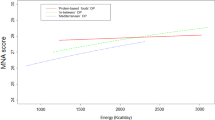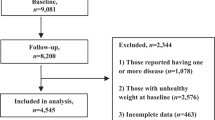Abstract
Background/objectives
To derive dietary patterns and examine their longitudinal associations with sociodemographic and lifestyle factors in the Tasmanian Older Adult Cohort.
Subjects/methods
This is a corrected analysis of a retracted paper. We followed 1098 adults aged ≥50 years for 5 years. Dietary intake was assessed using a validated food frequency questionnaire. Baseline dietary patterns were identified using exploratory factor analysis and scores at each time point calculated using the weighted sum score method. Associations of energy-adjusted dietary pattern scores with participant characteristics were assessed using linear mixed-effects models.
Results
The four dietary patterns identified were: fruit and vegetable (vegetables, potatoes, fruits); animal protein (poultry, red meats, fish); snack (snacks, sweets, nuts); western (meat pies, hamburgers, pizzas). Fruit and vegetable pattern scores were lower in men and current smokers at baseline. Animal protein scores were lower in older and retired people but higher in men and smokers at baseline. The sex difference in animal protein score increased over time (p = 0.012). At baseline, snack score was positively associated with age and physical activity, but lower in men and current smokers. The effect of age on snack score lessened over time (p = 0.035). Western scores were lower in older people but higher in men, current smokers and those living in disadvantaged areas at baseline. The effect of age on western score reduced over time (p = 0.001).
Conclusions
The higher scores for healthy and/or lower scores for unhealthy patterns in men, smokers, retirees and those experiencing social disadvantage suggest these could be target groups for interventions to improve diet quality in older adults.
This is a preview of subscription content, access via your institution
Access options
Subscribe to this journal
Receive 12 print issues and online access
$259.00 per year
only $21.58 per issue
Buy this article
- Purchase on Springer Link
- Instant access to full article PDF
Prices may be subject to local taxes which are calculated during checkout


Similar content being viewed by others
References
Iburg KM. Global, regional, and national disability-adjusted life-years (DALYs) for 333 diseases and injuries and healthy life expectancy (HALE) for 195 countries and territories, 1990–2016: a systematic analysis for the Global Burden of Disease Study 2016. Lancet. 2017;390:1260–344.
World Health Organization. Nutrition. https://www.who.int/nutrition/topics/2_background/en/.
Lim SS, Vos T, Flaxman AD, Danaei G, Shibuya K, Adair-Rohani H, et al. A comparative risk assessment of burden of disease and injury attributable to 67 risk factors and risk factor clusters in 21 regions, 1990–2010: a systematic analysis for the Global Burden of Disease Study 2010. Lancet. 2012;380:2224–60.
Newby P, Tucker KL. Empirically derived eating patterns using factor or cluster analysis: a review. Nutr Rev. 2004;62:177–203.
Kim J, Yu A, Choi BY, Nam JH, Kim MK, Oh DH, et al. Dietary patterns and cognitive function in Korean older adults. Eur J Nutr. 2015;54:309–18.
Cade JE, Taylor EF, Burley VJ, Greenwood DC. Does the Mediterranean dietary pattern or the Healthy Diet Index influence the risk of breast cancer in a large British cohort of women? Eur J Clin Nutr. 2011;65:920–8.
Ocké MC. Evaluation of methodologies for assessing the overall diet: dietary quality scores and dietary pattern analysis. Proc Nutr Soc. 2013;72:191–9.
Jomaa L, Hwalla N, Chamieh MC, Naja F, Itani L, Mehio-Sibai A. A Lebanese dietary pattern promotes better diet quality among older adults: Findings from a national cross-sectional study. BMC Geriatr. 2016;16:85.
Markussen MS, Veierød MB, Kristiansen AL, Ursin G, Andersen LF. Dietary patterns of women aged 50–69 years and associations with nutrient intake, sociodemographic factors and key risk factors for non-communicable diseases. Public Health Nutr. 2016;19:2024–32.
Andreeva VA, Allès B, Feron G, Gonzalez R, Sulmont-Rossé C, Galan P, et al. Sex-specific sociodemographic correlates of dietary patterns in a large sample of French elderly individuals. Nutrients. 2016;8:484.
Hsiao PY, Mitchell DC, Coffman DL, Allman RM, Locher JL, Sawyer P, et al. Dietary patterns and diet quality among diverse older adults: the University of Alabama at Birmingham study of aging. J Nutr Health Aging. 2013;17:19–25.
Chan R, Chan D, Woo J. Associations between dietary patterns and demographics, lifestyle, anthropometry and blood pressure in Chinese community-dwelling older men and women. J Nutr Sci. 2012;1:e20.
Thorpe MG, Milte CM, Crawford D, McNaughton SA. A comparison of the dietary patterns derived by principal component analysis and cluster analysis in older Australians. Int J Behav Nutr Phys Act. 2016;13:1–14.
Abdollahi S, Zeinali F, Azam K, Toupchian O, Djafarian K. Identifying major dietary patterns among the elderly in Tehran Health Homes, Jundishapur. J Health Sci. 2015;7:e30395.
Harrington JM, Dahly DL, Fitzgerald AP, Gilthorpe MS, Perry IJ. Capturing changes in dietary patterns among older adults: a latent class analysis of an ageing Irish cohort. Public Health Nutr. 2014;17:2674–86.
Nguyen HH, Wu F, Oddy WH, Wills K, Brennan-Olsen SL, Jones G, et al. Dietary patterns and their associations with socio-demographic and lifestyle factors in Tasmanian older adults: a longitudinal cohort study. Eur J Clin Nutr. 2019;73:714–23. https://doi.org/10.1038/s41430-018-0264-1. Epub 7 Aug 2018.
Nguyen HH, Wu F, Oddy WH, Wills K, Brennan-Olsen SL, Jones G, et al. Retraction Note: Dietary patterns and their associations with socio-demographic and lifestyle factors in Tasmanian older adults: a longitudinal cohort study. Eur J Clin Nutr. 2020;74:214.
Gardener SL, Rainey-Smith SR, Barnes MB, Sohrabi HR, Weinborn M, Lim YY, et al. Dietary patterns and cognitive decline in an Australian study of ageing. Mol Psychiatry. 2015;20:860–6.
Keogh JB, Lange K, Syrette J. Comparative analysis of two FFQ. Public Health Nutr. 2010;13:1553–8.
Ding C, Quinn S, Jones G, Cicuttini F, Parameswaran V, Burgess J. Serum levels of vitamin D, sunlight exposure, and knee cartilage loss in older adults: the Tasmanian older adult cohort study. Arthritis Rheum. 2009;60:1381–9.
Balogun S, Aitken D, Winzenberg T, Wills K, Scott D, Callisaya M, et al. Longitudinal associations of serum 25-hydroxyvitamin d, physical activity, and knee pain and dysfunction with muscle loss in community-dwelling older adults. J Gerontol A Biol Sci Med Sci. 2017;1–6.
Brennan S, Winzenberg T, Pasco J, Wluka A, Dobbins A, Jones G. Social disadvantage, bone mineral density and vertebral wedge deformities in the Tasmanian Older Adult Cohort. Osteoporos Int. 2013;24:1909–16.
Australian Bureau of Statistics. Census of population and housing: socio-economic indexes for areas; Australia 2001 number 2039.0. 2001.
Scott D, Blizzard L, Fell J, Jones G. Prospective associations between ambulatory activity, body composition and muscle function in older adults. Scand J Med Sci Sports. 2011;21:e168–75.
Osborne JW. What is rotating in exploratory factor analysis. Pract Assess Res Eval. 2015;20:1–7.
Beavers AS, Lounsbury JW, Richards JK, Huck SW, Skolits GJ, Esquivel SL. Practical considerations for using exploratory factor analysis in educational research. Pract Assess Res Eval. 2013;18:1–13.
Williams B, Onsman A, Brown T. Exploratory factor analysis: a five-step guide for novices. J Emerg Prim Health Care. 2010;8:1–13.
Little RJ, D’Agostino R, Cohen ML, Dickersin K, Emerson SS, Farrar JT, et al. The prevention and treatment of missing data in clinical trials. N Engl J Med. 2012;367:1355–60.
Vansteelandt S, Carpenter J, Kenward M.Analysis of incomplete data using inverse probability weighting and doubly robust estimators. Methods Eur J Res Methods Behav Soc Sci.2010;6:37–48.
StataCorp. Texax 77845 USA ed: College Station; 2016.
FDA US Food and Drug Administration. Tobacco use and men’s health. https://www.fda.gov/tobacco-products/health-information/tobacco-use-and-mens-health#references.
Mayén A-L, Marques-Vidal P, Paccaud F, Bovet P, Stringhini S. Socioeconomic determinants of dietary patterns in low- and middle-income countries: a systematic review. Am J Clin Nutr. 2014;100:1520–31.
Bartholomew DJ, Knott M, Moustaki I. Latent variable models and factor analysis: a unified approach: John Wiley & Sons; 2011.
Reedy J, Subar AF, George SM, Krebs-Smith SM. Extending methods in dietary patterns research. Nutrients. 2018;10:571.
Krok-Schoen JL, Archdeacon Price A, Luo M, Kelly OJ, Taylor CA. Low dietary protein intakes and associated dietary patterns and functional limitations in an aging population: a NHANES analysis. J Nutr Health Aging. 2019;23:338–47.
Ni Lochlainn M, Bowyer RCE, Steves CJ. Dietary protein and muscle in aging people: the potential role of the gut microbiome. Nutrients. 2018;10:929.
Bauer J, Biolo G, Cederholm T, Cesari M, Cruz-Jentoft A, Morley J, et al. Evidence-based recommendations for optimal dietary protein intake in older people: a position paper from the PROT-AGE study group. J Am Med Dir Assoc. 2013;14:542–59.
Acknowledgements
We thank all organizations that have provided funding for this research.
Funding
National Health and Medical Research Council of Australia (302204); Arthritis Foundation of Australia (MRI0616); Tasmanian Community Fund (D0015018); Masonic Centenary Medical Research Foundation; and University of Tasmania Institutional Research Grants Scheme (D0015019). SB-O was supported by a National Health and Medical Research Council (NHMRC) of Australia Career Development Fellowship (GNT1107510). HHN is supported by the scholarship of University of Tasmania. FW was supported by an Arthritis Foundation Australia—Australian Rheumatology Association Heald Fellowship, funded by the Australian Rheumatology Association and Vincent Fairfax Family Foundation. FW is supported by a NHMRC Early Career Fellowship (APP1158661). GJ is supported by a NHMRC Practitioner Fellowship (1117037).
Author information
Authors and Affiliations
Contributions
TW contributed to developing the research proposal and data analysis. GJ, Chief Investigator of TASOAC contributed access to the study, expertize in identifying exposures, confounders and outcomes. KW contributed to the design and implementation of the data analysis. WO provided advice relating to interpretation of the dietary patterns identified in this study and of the study results. FW contributed to the interpretation of findings. SB-O cross-matched and coded the SEIFA data, and contributed to the interpretation of findings relating to those data. HHN wrote the research proposal and manuscript, analyzed and interpreted the data, and edited the manuscript for publication. All authors contributed to the writing and revision of the manuscript for publication.
Corresponding author
Ethics declarations
Conflict of interest
There is no conflict of interest of any of the co-authors of this manuscript.
Additional information
Publisher’s note Springer Nature remains neutral with regard to jurisdictional claims in published maps and institutional affiliations.
Supplementary information
Rights and permissions
About this article
Cite this article
Nguyen, H.H., Wu, F., Oddy, W.H. et al. Longitudinal associations of dietary patterns with sociodemographic and lifestyle factors in older adults: the TASOAC study. Eur J Clin Nutr 75, 759–767 (2021). https://doi.org/10.1038/s41430-020-00802-4
Received:
Revised:
Accepted:
Published:
Issue Date:
DOI: https://doi.org/10.1038/s41430-020-00802-4
This article is cited by
-
The Effect of Dietary Patterns on Reducing Falls and Falls Risk in Adults: A Systematic Review
Current Nutrition Reports (2024)
-
Associations between body composition, physical activity, and diet and radial bone microarchitecture in older adults: a 10-year population-based study
Archives of Osteoporosis (2022)
-
Retraction and re-submission
European Journal of Clinical Nutrition (2021)



